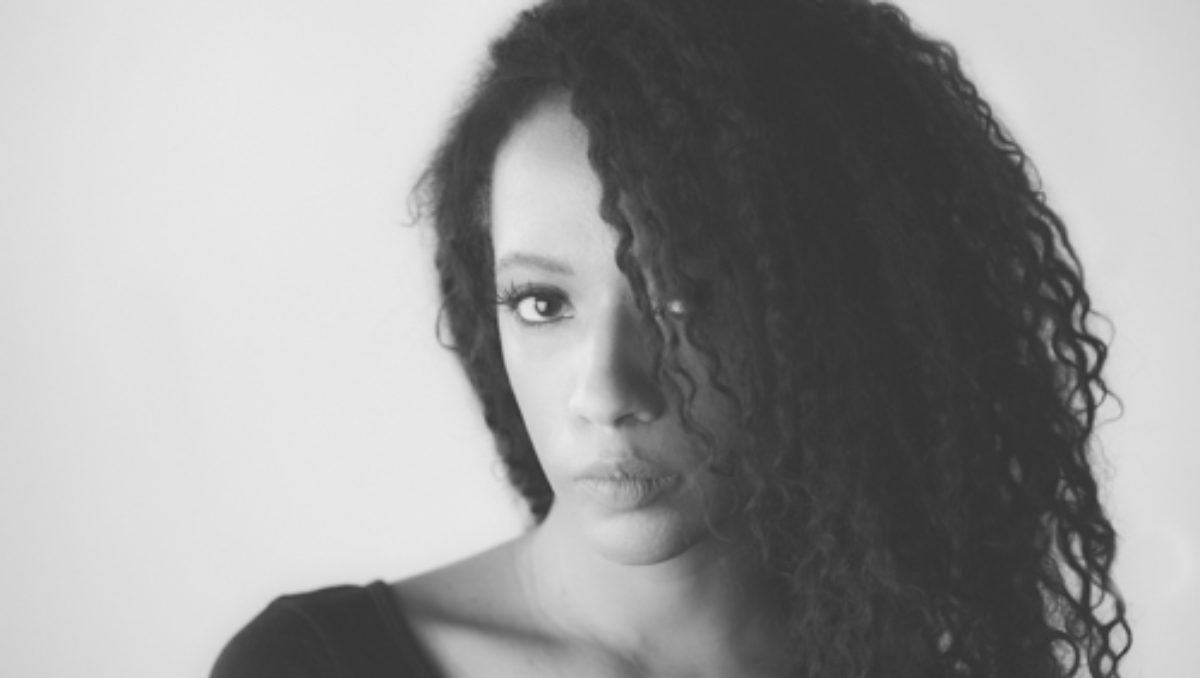INTERVIEW WITH Rachel Eliza Griffiths
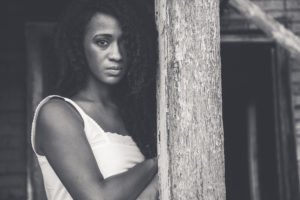
Courtesy of Rachel Eliza Griffiths
Rachel Eliza Griffiths is a multimedia artist, poet, and writer. Griffiths is the author of Miracle Arrhythmia (Willow Books 2010), The Requited Distance (The Sheep Meadow Press 2011), Mule & Pear (New Issues Poetry & Prose 2011), which was selected for the 2012 Inaugural Poetry Award by the Black Caucus of the American Library Association, and Lighting the Shadow (Four Way Books 2015), which was a finalist for the 2015 Balcones Poetry Prize and the 2016 Phillis Wheatley Book Award in Poetry. Her most recent book, Seeing the Body, is a hybrid of poetry and photography (W.W. Norton and Company).
FWR: I’d like to start with the titular poem, “Seeing the Body”. In it, you write into grief and how that grief can bifurcate the life of the living. In your visualization of grief, you create imagery (such as “flowers/falling from her blood” and “bale of grief on my back, opening/ into something black I wear”) that seems resistant to more common depictions of grief. (I’m thinking of poems like Auden’s “Funeral Blues” or the gothic imagery of Edgar Allen Poe, which have become synonymous with writing about loss). Did you find yourself resisting cliche, or writing through images that you had read from others, when you first began these poems?
Rachel Eliza Griffiths: The engine of “Seeing the Body” relies on how breathing happens through a poem as much as it is also about how breath stops or is altered by grief. There is the involuntary tension of trying to sustain an image or to construct a narrative about a beloved’s life or one’s self, only to find all is ruptured.
Auden’s wonderful poem is after something very different than “Seeing the Body” insomuch as Auden’s poem calls for a moment of silence that feels quite public in its address of ordinary life. My own poem wants intimacy, to address the earth and the private echo of silence where there is the sense of falling through one’s body, one’s birth and death through the body of the mother. My mother. This poem hurt me the entire time I worked on it. Years. I’ve never been attracted to clichés, visually or otherwise, so I don’t think about resisting them. What has startled and provoked me is the immediate emotional connection I feel wherever I share these poems. I’m writing about a “common” experience yet it is anything but common for me.
I can never read this poem as it should be read. That was intentional. Each time I enter the earth of this poem I am further away from its original grief. I am somewhere else in my body and can’t get back to the woman who braced herself against the initial impact of loss. Whenever anyone experiences this poem I hope there is an intimacy of reading that does not exclude our bodies. Through language, I’m aware of forcing myself to stop in the middle of something that has neither beginning nor end.
Listen to “Seeing the Body” read by Rachel Eliza Griffiths
FWR: Seeing the Body includes a section (“daughter: lyric: landscape”) composed of your photography, which is alluded to in other poems (“For years I photographed myself/ in a white dress”, from “Husband”). You write in your Author’s Note that these photos serve “as a map of the self and of the greater world in which [you] are both visualized and invisible”. Had you planned on incorporating photography from the beginning, or how did that process develop?
Griffiths: In the beginning, I didn’t plan to use any images at all in the book except I began to think about the types of photographs I had created in Mississippi just before she died. I had to go back and consider what I was “making” when I was unmade by her death. Then I also remembered the deliberate focus I gave photography immediately after her death. I clung to the machine, my camera, like a life raft. I began to perceive my own body as an urgent conduit of my grief, which meant I couldn’t leave my body outside of any landscape on the page.
Perhaps the only way now that I can truly see my mother’s body again is through studying my own. This time was weird and messy because I couldn’t read books. I had a hard time using my camera. All these tools were nothing to me. When I began to write about my mother, it was very difficult because it felt like language was forcing me to accept elements of her death I couldn’t bear.
Perhaps the only way now that I can truly see my mother’s body again is through studying my own.
FWR: Did this impact your understanding of or play with syntax? (I’m thinking here of the poems “As” and “Good Questions”).
Griffiths: “As” and “Good Questions” are fragmentary or function as what I might call a “collage of the lyric” — the rhythm and imagery bleed together in an attempt to both isolate language and to hold the visible language intact as grief itself opens through the body of the page. Photographs offered me a way to be grounded in the world, to remember there had been a world I loved before her death and that I could and must return to it. Finally, it was transformative, after so many years of being diligent that these mediums lived in separation, to ask them to touch each other and hold me.
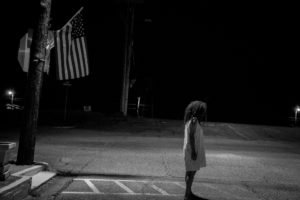
Courtesy of Rachel Eliza Griffiths
FWR: “Color Theory and Praxis (I)” is a poem concerned with the body, but also the body in art. Specifically, it considers the painting “Open Casket” by Dana Schutz, which depicts Emmett Till. The poem questions who has the right to the body, particularly a body of color, and after death. I wonder if this influenced your own writing, as some of your poems see you imagining the voice of your mother, as in “Comedy”: ‘Yeah don’t go and write about me like that/ she says. I already know you will.’
Griffiths: I’m ambivalent about my relationship to placing myself inside the voices and bodies of others. I’ve done it, whether by persona or in certain photographic series, and it can feel tense for me. Issues of permission and imagination fascinate me. I’m not interested in policing anyone but I do have the right to challenge, to question, and to critique certain things, especially when it comes to visual arts and representation. There is a lot at stake for me even when it feels like people want artists to shut up when their work is confrontational. I read an interview where Schutz said the painting was about a conversation with Till’s mother. I disagreed with her perspective and the “terms” of this unreal, fantastical conversation, which placed the mutilated body of a black mother’s son as its focal point, as its medium. There is a photograph of Mamie Till at her son’s casket. I don’t feel like Schutz’s painting could ever listen to, or tell Mamie Till’s truth. The artist has a right to do whatever she wants but I tried to understand what and where that right was located. I mean, there’s a painting of hers that features Michael Jackson’s body on an autopsy table. Again, do what you want but do it well. Also, I noticed she didn’t use Trayvon Martin’s image, or Sean Bell’s, Tamir Rice’s, or Eric Garner’s, or Jordan Davis’, or Philando Castile’s, or Mike Brown’s, or Ahmaud Arbery’s, or…or…
I’m tired. There isn’t enough canvas, enough pigment, enough bones in this country for black artists to address the violence and harm done to our bodies, our communities, by the imaginations or institutions that can’t bear for us to live. It isn’t our job or our art’s job to do that work either. Why is America afraid that we dare to imagine ourselves as anything but dead?
My mother and I would go back and forth about my writing. Sometimes she’d ask me when I was going to write her story. Other times she worried about my imagination. None of the poems in “Seeing the Body” ever enter my mother’s body and use her voice. I never wanted to do that. The dialogue in “Comedy” was exactly what she said.
It isn’t our job or our art’s job to do that work either. Why is America afraid that we dare to imagine ourselves as anything but dead?
FWR: In “Good Questions”, you write, “when did the final arrangements begin? / At her birth. Inside of wet rock. When my birth began.” Throughout the text, I was struck by your exploration of inheritance, whether of womanhood or illness, and how grief lives in the body (as in “Signs”). Would you speak to the development of this thread?
Griffiths: I’m in a more explicit stage of my life where I want to think of myself within a greater dimension, in conversation with beings that arrived before me, and those who are already arriving after me. I think about what I can share with the living and the dead. I’m constantly aware that the earth is different in her temperament since I was born. I’ve been astonished by how quickly some of our geographies have reverted and have healed during the pandemic without the presence of human abuse.
At this point, my work lends me an expansive way to think about how I might, as an artist, establish or assert my own lineage or claim inheritance in ways that don’t necessarily include children. I’m constantly thinking about how remarkable it is to begin to really take into consideration the manners, culture, trauma, resilience, joys, and ways-of-being that I have inherited. These things I hold have come from my family but they have come from a larger consciousness. They also come from within me.
I’m in a more explicit stage of my life where I want to think of myself within a greater dimension, in conversation with beings that arrived before me, and those who are already arriving after me. I think about what I can share with the living and the dead. I’m constantly aware that the earth is different in her temperament since I was born.
FWR: Seeing the Body explores the shifting ownership of the female body and how language can free, as well as constrain. In “Ars Poetica”, you write of imagining becoming a writer or a woman like your mother, before the neighbor and his friend interrupt your daydream: “his friend braked hard,/ barking like a dog… Hey, Bitch, he said”. In “My Rapes” your mother asks, “why/ I listened to white girl shit. How could alternative music/ hear a black cry like mine?” Can language free us from the body?
Griffiths: It depends on so many things – whose language, which bodies, whose freedom, whose history, or memory. “Ars Poetica” speaks about some of the ways that violence can interrupt one’s dreams or one’s work. The poem is also asking questions about how we, especially black women, can afford our dreams and our work. How the world consistently fails to appraise our contributions even while our bodies and cultures will be taken as commodities, as resources. The second poem you mentioned is about some of the ways your own family will refuse to allow you (and by extension, your body) to live in songs (and bodies) that they believe are dangerous. I listened to a lot of Tori Amos because of what had happened to me. I listened to Fiona Apple, Ani DiFranco. I listened to them because my mother wouldn’t hear my truth. She couldn’t bear the thought of violation because she loved me so much.
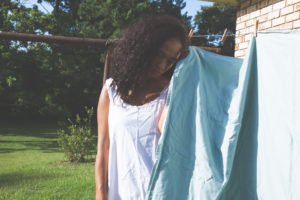
Courtesy of Rachel Eliza Griffiths
Listen to “Arch of Hysteria, Or, the Spider-Mother
Becomes A Woman” read by Rachel Eliza Griffiths
FWR: Building off of that question, you thread myth through your poems. For me, the inclusion of Athena, Arachne and Eurydice roots your experiences in grief and voicelessness within a larger historical and human story of being a woman. And the poem “Myth” speaks of “the literature/ of blood the black face gasps in air. No… / the black boy’s face merely insists/ it is a face to begin with”, which, to me, seems reminiscent of the commodification of bodies of color not only in commerce, but also in art. Can you talk a bit about the inclusion of these figures?
Griffiths: This question feels similar to the earlier question about Till. In some parts of the book, I found myself returning to stories about daughters who were powerful but seemed unable to overcome their roles in a larger “myth” or story. These stories would often place women inside of cruelty and violence – rapes, murders, or “transformations” that altered or punished their bodies, or drove them mad. The poem “Myth” is about my rage as well as my grief that murders of black men persist in a cycle that renders them faceless, whether that is through death or incarceration. And there is a spectrum of micro-massacres between those extremes. Their humanity is erased.
FWR: Were there poets or writers you turned to for guidance as you wrote through your grief? (Lucille Clifton’s “oh antic god” springs to mind). Or, are there poets or poems you love to teach or share?
Griffiths: Yes, I return often to Ai and Lucille Clifton! I’m thrilled at the forthcoming publication of a selected, How to Carry Water (BOA Editions Ltd.), edited by my dear sister, Aracelis Girmay. It will be a feast! When my mother died, Aracelis shared a poem with me by Joy Harjo, our current National Poet Laureate. It’s called “Remember” and I read it aloud often. If I were brave enough to get a tattoo it would feature lines from this poem.
- Published in home, Interview, Uncategorized
ON THE PHOTOGRAPH: AN INTERVIEW with Rachel Eliza Griffiths
from FWR Poetry Editor Nathan McClain:
While at Cave Canem, I had the opportunity to chat with, and interview, poet and photographer Rachel Eliza Griffiths on the functionality and nature of photography and, more specifically, how aspects of the gaze and engagement contribute to a photo’s overall work. Her responses were far too wonderful and in-depth to distill, so I’ve provided Rachel Eliza’s responses, in their entirety, for your perusal. Rachel Eliza, too, provided us with a photo essay, which I’ve embedded in her response, as I sense the two are in conversation.
A poem, or a photograph, after it leaves you, is a virus that exists in the world. It replicates itself and, despite its framing, it cannot be contained. My hope is that Rachel Eliza’s photos and responses affect, or maybe more so infect, you…
NM: How would you say the photograph directs the gaze in a way the poem may not?
REG: I want to be careful to not make any sweeping statements, as your questions are so interesting and fluid to me. I’ll think of these questions for years. I admit that I feel the photographer in me resisting my efforts to verbalize or theorize the parts of me where my visual alphabet works in terms of imagination and politics. There is obviously as much nuance within photography and photographers as there is amongst poets and the tools/language they employ to shape, light, and to shadow their work. For me, there are shared spaces between imagery and vocabulary and other spaces where neither can help, witness, direct, or translate the other.
The presence of tension and intuition, whether in a poem or photograph, is critical for me in terms of process. When I think of process, I think of my body and of its systems. How I experience my body, as I am writing, is distinct from the sensations I experience when I’m using my camera. For both, landscape – where I am and with whom and where, the specific geography – becomes literal, internal, spectral, exterior. I don’t resist these contradictions. I get away from squares, unless they are pages or viewfinders. For a while, all shapes are doors, stairs, and windows. After photographing, I feel my work in my muscles, my back, hips, and arms. They’re sore. When I write I have to remember my body. I look up and hours may have passed without me even getting up for a glass of water.
In a photograph, I have to meet myself as an “I” in ways that I’m unable to articulate in a poem. But I don’t see this as a failure. The mood or space where tension exists comes from the same vulnerability, the same power. In a poem the “I” is working at something, so interior, that the photograph can barely perceive it, much less reveal it in its entirety to my own gaze.
For example, many of my self-portraits included here incorporate blurring. If I take an image of myself and I seem too still in it I feel as if I’m dead somehow. I get freaked out. Blurring helps me see how spiritual I am and reminds of how the past, present, and future can function in a two-dimensional portrait of one’s self. I don’t necessarily need narrative but I often like to sense movement in the environment, which is also living and moving.
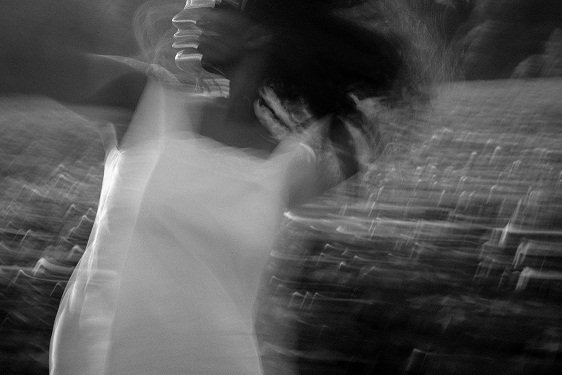
When I’m looking at myself I’m hoping for discovery. I accept the outside and reject the outside. I accept the inside and reject the inside. I use language and I subvert language. Texture, color, light, shadow, frame/composition, sound, absence, voices, and faces become surrogates for what I cannot say. Recently I began to incorporate my body in photographs. That space is difficult to metastasize, or offer in my poems because of how freighted and unstable language can be. I think of alchemy, authority and permission, and how those relate to photographers and to poets. Sometimes I think of the gaze and I think about beauty and desire and violence. I think about how a poem about my body might be received if it were placed next to an image of my body. I try to let the work say it because the work knows it better and more honestly than grammar. People will say a photograph does not lie but, of course, photographs lie too.
But photographs and poems also become glyphs – they’re 2D. I’m not. I have to push at them, break them, to give them bones and flaws and flesh that can outlive me. There is a relationship that must happen immediately, structurally, thematically, and psychologically between the poet and the reader. Mortality happens between the poet and reader. The photograph itself happens immediately and then, if the photograph is strong enough, it will reverberate and live, sometimes hidden for years, inside of the gaze where it was first experienced.
Time in a photograph also splices and freezes an experience in a way that I feel a strong poem can also transform its reader. For example, consider the past and the future. I don’t know if the present tense exists in photographs but it does, often, in poems. When I invoke the past or the future in a poem I don’t see it with the same lifespan a photograph holds. Photographers can photograph or intuit the future but the implication of doing that almost goes against the common intention of most images, which are snapshots, which is to convey what Reality is/was like. With the “likeness” being accurate enough to the real. Being ‘accurate’ in a poem has little value or meaning unless it is part of the poem’s truth. It is easier for us to accept a photograph or dismiss it as, ‘that’s not real’ in a way that does not happen easily in a strong poem. Poems make us believe in ways that photographs aren’t necessarily concerned with – and this calls into light the places where the air thins between these ideas.
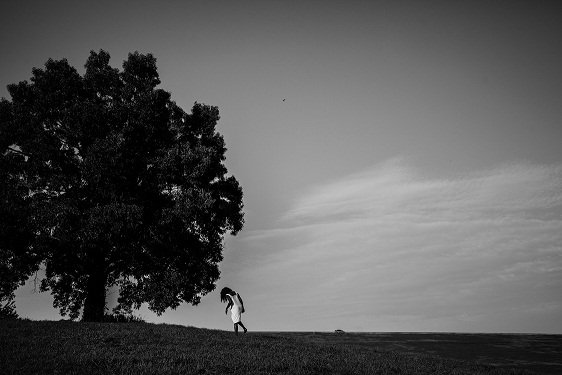
Our world is so visually conscious of itself. While certain types of cropping or manipulation, lack of credit, laws of fair use, etc. in a photograph can be egregious sites of outrage, manipulation in a photograph is usually not as averse to our reaction to feeling manipulated by a poet. Is there more at stake when we, in our roles as “readers”, are manipulated?
Most of the time we assume that the photograph we are seeing has been revised, edited. And a photographer is more likely to have a photograph plagiarized or appropriated (without much consequence) than a poem. Some photographers are okay with this because of how democracy, amongst photography, works in its contemporary republic. Most people would never quote or use a poet’s work without providing some attribution or credit. But photographers expect this and as such, there are photographers who make their living by selling ‘stock’ images. ‘Stock poetry’, wherever it appears, is usually derided. As viewers, we are more likely to be impressed and admire a skilled photographer’s manipulation of an image than we might necessarily be if we were to witness a certain type of cleverness or verbal pyrotechnics in a poet’s toolbox. We might be dismissive of that poet for being ‘experimental’ or ‘too much’ or find such dazzling attempts as distractions from the work itself.
There’s The Gaze too. I don’t have enough space to go into that! But reciprocity is part of this conversation. We must speak of what is private and public within the context of the gaze. What is authorized. What is banned. What is legislated and outlawed. Do we judge the photographer for immorality or ethical trespass in the same way we might apply such concepts to a poem or a poet? When a photographer has the opportunity to ‘take the shot’ (always this hyper-aggressive vocabulary of taking, shooting, capturing), what is at stake? What is at stake for a poet who gives voice to those who cannot speak? What is at stake for a photographer, who looks, makes visible the necessary moment, when the world will not see or would not see otherwise? What is at stake when the poet executes that identical gesture? How do we compare the notion of silence and speech when it occurs in either poem or photograph?
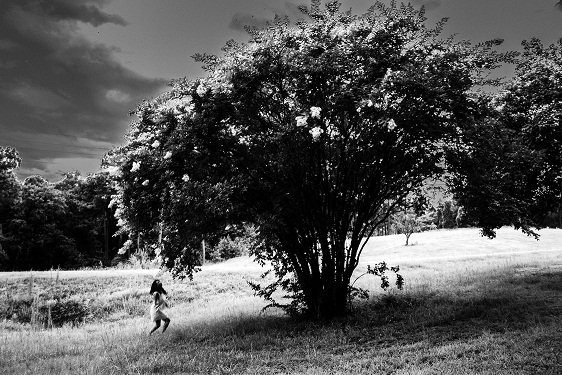
Depending on who is looking, the photographer is as much the object and subject as the production of the final image. For example, consider celebrity photographers whose celebrity will sometimes be noted and lauded before any actual attention is given to the work. I believe that this happens, but a bit differently, with poets. The notion of a photographer as ‘author’ can be as expansive as the poet’s task. But there are other elements to examine for both poet and photographer including accountability, anonymity, privilege, intention, politics, ethics, and of course, imagination. Again, it depends on the type of photographer. War photographers need different tools than underwater photographers or wedding photographers. I don’t have any judgment about this. I believe it’s about the way you feed your eyes, what you must look at and what you need to see and every wound of gray in between.
NM: Is there a way in which we engage with a photo that we do not with a poem?
REG: There are many ways! I think about this all of the time so I don’t have a static answer. We engage poems differently, even amongst ourselves, as readers of poetry. We assign value (and outrage) in dynamic terms when it comes to photography in ways we might not when we are reading. We engage photographs differently when they appear in museums, advertisements, family albums, or social media. Many of us are curating various narratives and lifelines with our ‘smart’ devices. There is also a global coherence that is happening now, irreversibly, because of technology. This is complicated, revolutionary, amazing, and dangerous.
If I read a poem written in English it possesses a distinct fluency because my first language is English. In which language(s) do we experience photographs? Many of my favorite photographers are not American. But how can you look at photograph and immediately discern its author’s identity or where that photographer is from? How does the concept of universality relate to a photograph beyond the image itself and for its own sake?
With poems, it’s interesting. If I’m reading a poem that was originally written in French, I’m likely to look at several translations or ask friends for suggestions for the most informed version. I’ll be looking for the best version, the closest version. I have to do more work because I want to experience the language of the poem as closely to its original text as possible. All translations are not equal but how would that notion manifest in photography?
Intimacy is also something I often think about in relationship to both poetry and photography. The intimacy I might share in a photograph is neither identical nor lateral to the intimacy I share in a poem. Both forms engage different threads of the gaze. These forms are often contradictory in relation to the acceptance or rejection of the gaze. The shapes of the gaze in either medium are relative to my content and intention. For me, any attempt to answer this question only provokes questions. Who is the We? How do we, as individuals and public citizens, understand, maintain, and define ‘literacy’? Personally, I’ve had numerous experiences where there is concerned.
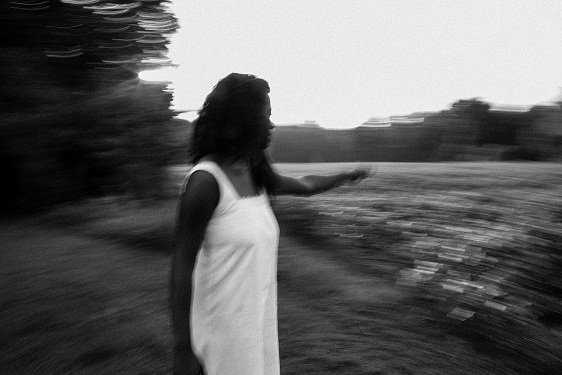
Photography’s functions are not identical to poetry’s processes and forms. Perhaps poetry and photography are fraternal twins. If I look at a photographer’s work my dialogue with that work happens in a matter of seconds. I find an opening, a narrative (however fragmented or fractured), a visual seduction or rhythm, an emotion that is persistent. Visceral. I find what fails in its complete articulation to be verbal or knowable.
TWO POEMS by Rachel Eliza Griffiths
DEAR AMERICA
I pick you up
& you are a child made of longing
clasped to my neck. Iridescent,
lovely, your inestimable tantrums,
I carry you back & forth
from the underworlds
where your giggles echo,
grow into howls.
Your alphabet wraps itself
like a tourniquet
around my tongue.
Speak now, the static says.
A half-dressed woman named Truth
tells me she is a radio.
I’m going to ignore happiness
& victory.
I’m going to undo myself
with music.
I pick you up
& the naked trees lean
into the ocean where you arrived,
shaking chains & freedom
from your head.
No metaphor would pull you
out of your cage.
Light keens for the dead.
& I’m troubled
by my own blind touch.
Did the ocean release
my neck? Did the opal waves
blow our cries to shore?
You don’t feel anything
in the middle of the night.
ANOTHER WOMAN’S COAT
for J.H.
Alone with snowfall & pockets
of silence beneath shining streetlamps,
I pull her coat closer, finding spaces
in its arms. These seams do not belong
to me. And I won’t know this yet –
slipping down snowy Remsen. I stop
on the promenade, I’m solitary again
& stare at the city edging
the East River. Air blowing stings,
stinging, I pull the hood down,
burrow inside her wordless
flesh. Alive from dancing
with friends, & the music
of that. Pulled over me
like an eyelid of glitter.
As much as Manhattan
glares, can its insect
windows make me out
here on the other side?
Gatsby’s green heart
of a wish. Or whatever
was above me
that looked at my mouth
& said, Yes, it’s enough, isn’t it?
Blinking, immeasurable
in snow that needles
like fire, I’ll walk,
a Siamese with ten shadows,
amongst dense brownstones.
Heart, what telescope do you inscribe?
Snow light growing the shadows
of sycamores & fire hydrants
into giants. The bare pine seller
stands. The streetlights change
for nothing. When I get to my door
I’ll reach for a key
that opens & returns me
to myself like a rune. Then I see
I’m wearing a coat
that isn’t mine. Her syllables
& smiles & the wit of another
woman’s neck lingering
in the lining. Sweetness
& irony & how you couldn’t
tell, in the dark, you could wear
something so intimate
& otherwise? Hearing her
hands & breasts & ribs
murmur inside of the down.
The feathers you now
warm with your own
body. Inseparable
as the music we shared
as we danced,
the holiday like flecks
of tinsel caught under
the god’s tongue. Julie,
I hope you’ll forgive
me for wanting to
verse your instrument,
& how, when Brooklyn
wasn’t looking, I made
angels against the air,
our skin, like words slipped back
beyond midnight & knowing
I have no other way
to bear my life, you
laugh at the café
where we meet
& tell me
when we give
our coats back
with wonder
for ourselves
that the dance
was so lovely
your legs hurt
in the morning.
Issue 6 Contents NEXT: Stack of Brightness by Rosalynde Vas Dias

